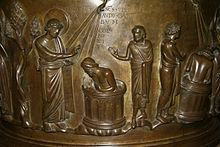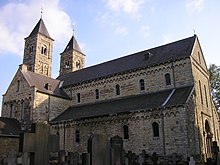



Mosan art is a regional style of art from the valley of the Meuse in present-day Belgium, the Netherlands, and Germany. Although in a broader sense the term applies to art from this region from all periods, it generally refers to Romanesque art, with Mosan Romanesque architecture, stone carving, metalwork, enamelling and manuscript illumination reaching a high level of development during the 11th, 12th and 13th centuries.
The Meuse river valley lay in the heart of the earlier Carolingian Empire and therefore the style draws largely from the heritage of the Carolingian art tradition. Thus, Mosan art contains strong classical elements, which separates it from the international Romanesque style seen elsewhere during the period, for example in France,[1] Germany[2] Spain and Italy. However, it shares with mainstream Romanesque art elements such as the treatment of space. Although the iconography of 11th- and 12th-century Meuse valley art largely draws on Biblical inspiration, some of the elaborately carved capitals in the two main churches in Maastricht depict scenes from many aspects of daily life, as well as images from an intriguing world of fantasy.
- ^ www.musee-moyenage.fr Archived 2005-10-17 at the Wayback Machine
- ^ www.musee-moyenage.fr Archived 2005-10-17 at the Wayback Machine